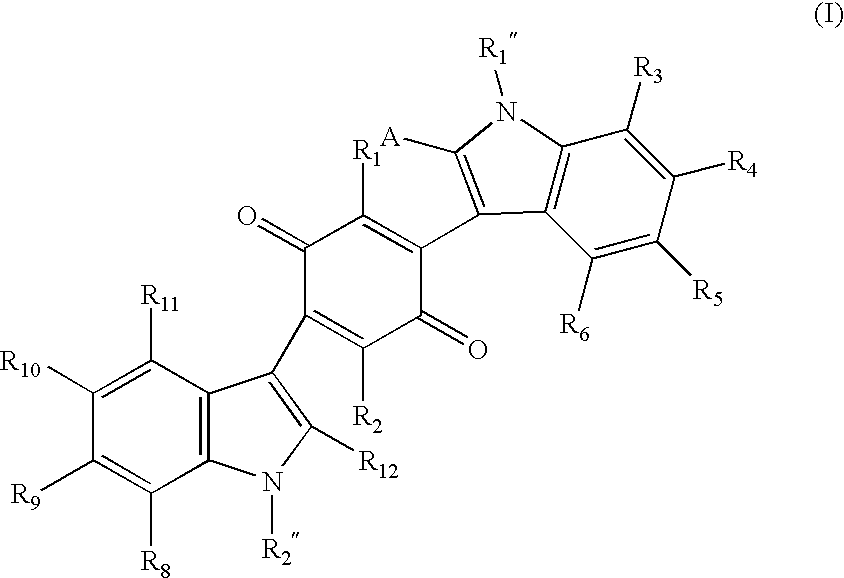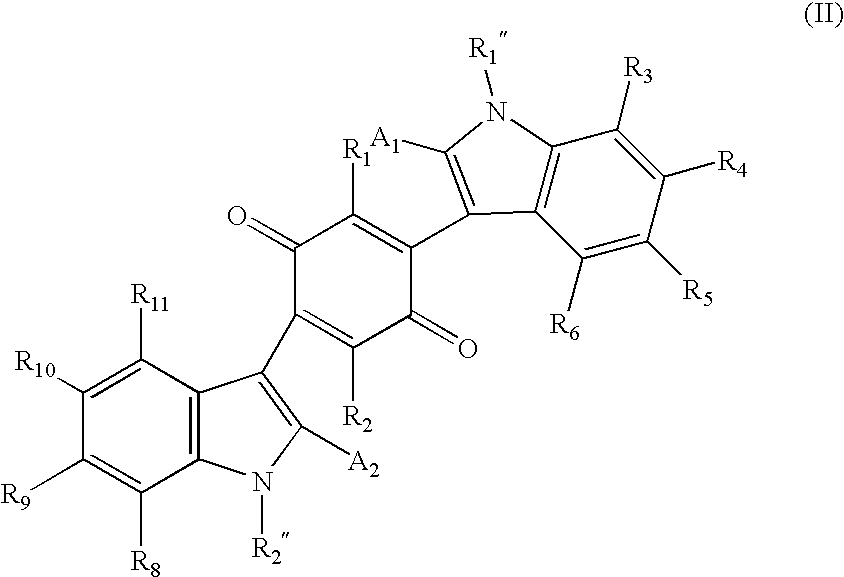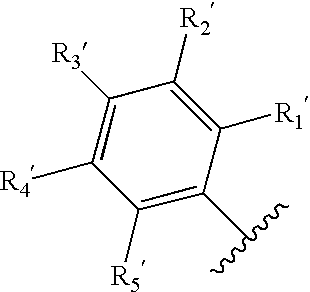Bis-indolyquinone compounds
a technology of indolylquinone and compound, which is applied in the field of indolylquinone compound inhibition, can solve the problems of troublesome separation of asterriquinones, limited natural occurring compounds, and inability to meet the needs of large-scale production of these compounds, so as to stimulate the activity of insulin receptor tyrosine kinase, reduce blood glucose level of patients, and reduce the effect of blood glucose level
- Summary
- Abstract
- Description
- Claims
- Application Information
AI Technical Summary
Benefits of technology
Problems solved by technology
Method used
Image
Examples
example 5.1.1
[0256] 2,5-Dihydroxy-3,6-di-[2-(3-methyl-n-butyl)indol-3-yl]-1,4-quinone
[0257] 1) Into a 250 ml round bottom flask, equipped with a magnetic stir bar, was placed 2-(3-methyl-n-butyl) indole (2.95 g), cesium carbonate (10.3 g) bromanil (3.34 g), and acetonitrile (79 ml). The mixture was stirred at room temperature for 45 hours. Following dilution with 1 N hydrochloric acid (250 ml), the crude mixture was extracted with ethyl acetate (500 ml). The organic layer was washed with brine (200 ml) and dried with sodium sulfate. After removal of solvent under reduced pressure, the crude residue was filtered through a short plug of flash silica, eluting with 20% ethyl acetate / hexane. The solvent was removed under reduced pressure, and the residue was purified by flash chromatography (15% ethyl acetate / hexane) to yield 2,5-dibromo-3,6-di-[2-(3-methyl-n-butyl)indol-3-yl]-1,4-quinone (553 g, 11%) as a blue crystalline solid.
[0258] Note: When the reaction was performed on 27.2 mg of starting indo...
example 5.1.2
[0263] 2,5-Dihydroxy-3,6-di-[2-(3-methyl-n-butyl)indol-3-yl]-1,4-quinone (larger scale)
[0264] 1) Into a 250 ml round bottom flask, equipped with a magnetic stir bar, was placed 2-(3-methyl-n-butyl)indole (30.0 g), cesium carbonate (62.6 g) bromanil (27.2 g), and acetonitrile (64 ml). The mixture was stirred at room temperature for 20 hours. Following dilution with 1N hydrochloric acid (500 ml), the crude mixture was extracted with ethyl acetate (1 L). The organic layer was washed with brine (400 ml) and dried with sodium sulfate. The solvent was removed under reduced pressure, the residue was purified by flash chromatography (30% ethyl acetate / hexane) to yield a 1:1 mixture of the desired product, 2,5-dibromo-3,6-di-[2-(3-m-ethyl-n-butyl)indol-3-yl]-1,4-quinone and the undesired by-product, 2,6-dibromo-3,5-di-[2-(3-methyl-n-butyl)indol-3-yl]-1,4-quinone (42.3 g, 46% yield of desired product by HPLC) as a blue crystalline solid.
[0265] 2) To a stirred solution of 1:1 mixture of 2,5-di...
example 5.1.3
[0267] 2,5-Dihydroxy-3,6-di-(2-n-butyl-indol-3-yl)-1,4-quinone
[0268] This compound was synthesized in the same manner as Example 2 except the starting indole was 2-n-butyl-indole.
[0269] Preparation of 2-n-butyl-indole
[0270] o-Toluidine (55 g) was mixed with 100 ml dry pyridine and 200 ml dry tetrahydrofuran in a 1-L 3-necked round bottom flask fitted with a Trubore stirrer, thermometer and a dropping funnel, under nitrogen. Then, with cooling in a refrigerated bath, valeryl chloride (60.3 g) was added dropwise over 1 hour. The mixture was stirred for another hour at room temperature and then poured onto 500 g ice and water. The precipitate was washed repeatedly with water on a Buchner funnel. The precipitate (88.9 g, 93%) was cyclized according to Verley and Bedure, 1925, Bull. Soc. Chim. Fr. (37): 190 to afford 2-n-butyl indole (67.4 g, 84%) as a very slightly yellow oil.
PUM
| Property | Measurement | Unit |
|---|---|---|
| pKa | aaaaa | aaaaa |
| temperatures | aaaaa | aaaaa |
| temperature | aaaaa | aaaaa |
Abstract
Description
Claims
Application Information
 Login to View More
Login to View More - R&D
- Intellectual Property
- Life Sciences
- Materials
- Tech Scout
- Unparalleled Data Quality
- Higher Quality Content
- 60% Fewer Hallucinations
Browse by: Latest US Patents, China's latest patents, Technical Efficacy Thesaurus, Application Domain, Technology Topic, Popular Technical Reports.
© 2025 PatSnap. All rights reserved.Legal|Privacy policy|Modern Slavery Act Transparency Statement|Sitemap|About US| Contact US: help@patsnap.com



